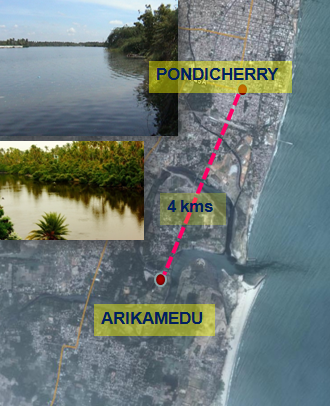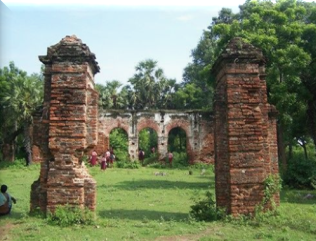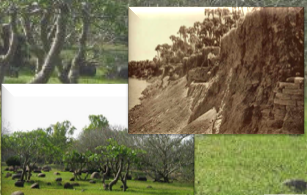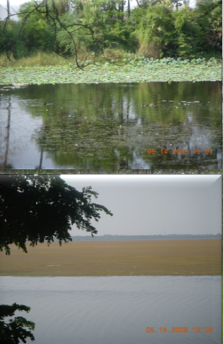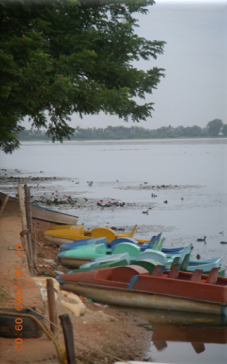Pondicherry (Puducherry)
This is a collection of articles archived for the excellence of their content. Readers will be able to edit existing articles and post new articles directly |
Contents |
Arikamedu
History & Significance: Arikamedu
Arikamedu is situated at the estuary of Ariyankuppam River and Bay of Bengal, the place is 4 km from Puducherry,Arikamedu is the earliest known settlement dating perhaps from the 2nd century BC, inhabited by people whose pottery relates to the Iron-age (megalithic) cultures of south India. The town extends along the banks of the River Ariyankuppam which is believed to be a navigable river during the 17th / 18th century and this led to Arikamedu becoming a major market town with maritime contacts between ancient India and Rome
M o rt i m e r Wheeler was the first to excavate at Arikamedu in 1945 and confirm that the fishing village was once a major Chola port that flourished for centuries by trading with the Romans. Later, Frenchman JM Casal (1947) and Vimala Begley of the University of Pennsylvania (1989-1992) conducted excavations.
The excavations display
1.The site had an established trade link between the Indian subcontinent and Mediterranean counties. 2.The inhabitants used to import goods (primarily from Mediterranean basin) such as Amphora, wines, Olive oil, ceramic items like Sigillata etc. Clothes(muslin).spices and beads were exported from this port.
3.Due to some natural calamities and other unforeseen reasons, the Arikamedu site was left unattended and the buildings became remains of history.
4.The Historic remains were declared as National Heritage Assets under the Ancient Monuments and Archeological Sites and Remains Act, (AMASR) 1958, and the Archaeological Survey of India (ASI) maintained it.
Towards the end of the 18th century the site was briefly occupied . In 1771-73 a seminary and residence was built for the Jesuit missionaries. The seminary was abandoned in 1783. The ruins of the seminary still survives and is known as Miss*ion House , which today is the only visible structure in the Arikamedu archeological site .
[[File: Visual Appraisal Of The Site.png| Visual Appraisal Of The Site |frame|left|500px]
Ossudu Lake
The qualities and opportunities
Location
1.Ousteri (or Oussudu) Lake is the largest lake in Pondicherry,8 sqkm water spread area-3.9 sqkm within Puducherry, located approximately 19 kms west of the town.
Visual / Scenic & Recreational
1.Presence of land running through the length of the Lake Bund which can be visually exploited. 2.Native vegetation trees, shrubs and undergrowth are ideally distributed around the periphery of the lake. 3.Quality and clarity of stored water a visually striking element may be reinforced with de-silting and removal of weeds.
Ecological
1.The Bombay Natural History Society, a member of Birdlife International, has designated Ousteri an Important Bird Area (IBA) of India – over 20,000 birds belonging to over 40 species used to reside or winter at Ousteri.
2.The Asian Wetland Bureau declared Ousteri one of 93 significant wetlands in Asia; and many of the birds recorded at Ousteri, including Spot-billed pelicans, Eurasian Spoonbills, Darters, Painted Storks, and Black-headed (or White) Ibis, are on the International Union for Conservation of Nature and Natural Resources (IUCN) Red List of Threatened Species.
3.This lake was one of the largest breeding sites for the Common Coot in South India, and many of the resident birds, such as the Purple Moorhen and Little Grebe, nested amidst floating vegetation present in the lake
Pondicherry
Puducheri, Pulcheri
The chief of the French Settlements in India, the capital of which, a town of the same name, is the head-quarters of their Governor. The town is situated on the Coromandel coast in 11degree 56' N. and 79degree 49' E., about 12 miles north of Cuddalore. It lies on the road leading from Madras to Cuddalore, and is the terminus of the Villupuram-Pondicherry branch of the South Indian Railway. The distance from Madras to Pondicherry is 122 miles by rail and 105 by road. The area of the Settlement is 115 square miles, and its population in 1901 numbered 174,456. It consists of the four communes of Pondicherry, Oulgaret, Villenour, and Bahur. The population of the town of Pondicherry in the same year was 27,448, of whom 12,904 were males and 14,544 females. Hindus numbered 14,544 and Christians 7,247, most of the latter being Roman Catholics. The history of the place is given in the article on the FRENCH POSSESSIONS. The Settlement was founded in 1674 under Francois Martin. In 1693 it was captured by the Dutch, but was restored in 1699. It was besieged four times by the English. The first siege under Admiral Boscawen in 1748 was unsuccessful. The second, under Eyre Coote in 1761, resulted in the capture of the place, which was restored in 1765. It was again besieged and captured in 1778 by Sir Hector Munro, and the fortifications were demolished in 1779. The place was again restored in 1785 under the Treaty of Versailles of 1783. It was captured a fourth time by Colonel Braithwaite in 1793, and finally restored in 1816.
The Settlement comprises a number of isolated pieces of territory which are cut off from the main part and surrounded by the British District of South Arcot, except where they border on the sea. This fact occasions considerable difficulty in questions connected with crime, land customs, and excise. The Collector of South Arcot is empowered to deal with ordinary correspondence with the French authorities on these and kindred matters, and in this capacity is styled the Special Agent, At Pondicherry itself is a British Consular Agent accredited to the French Government, who is usually an officer of the Indian Army. The town is compact, neat, and clean, and is divided by a canal into two parts, the Ville blanche and the Ville noire. The Ville blanche has a European appearance, the streets being laid at right angles to one another, with trees along their margins reminding the visitor of conti- nental boulevards, and the houses being constructed with courtyards and embellished with green Venetians. All the cross streets lead down to the shore, where a wide promenade facing the sea is again different
from anything of its kind in British India. In the middle is a screw-pile pier which serves, when ships touch at the port, as a point for the landing of cargo and, on holidays, as a general promenade for the population. There is no real harbour at Pondicherry ; ships lie at a distance of about a mile from the shore, and communication with them is conducted by the usual masula boats of this coast. Facing the shore end of the pier is a statue of the great Dupleix, to whom the place and the French name owed so much. It is surrounded by a group of carved stone columns which are said to have been brought from the ruins of the celebrated fort of GINGEE. Behind is the Place Dupleix (or Place de la Republique) with a band-stand ; and west again of this the Place du Gouvernement, a wide extent of grass with a fountain in the middle of it, round which stand the chief buildings of the town, including Government House, the Hotel de Ville, the High Court, and the barracks. Other erections in the town are the Secretariat, the Cathedral of Notre Dame des Anges, the college of the Missions trangeres, the Calve college, two clock-towers, a lighthouse, the hospital, and the jail. The town alsq contains a public library of about 16,000 volumes, and public gardens with a small collection of wild animals and birds.
Pondicherry was made a municipality in 1880, with a mayor and a council of eighteen members. The receipts and expenditure of this body during the ten years ending 1902 averaged Rs. 47,000. There is no drainage system ; but the water-supply is excellent, being derived from a series of artesian wells, which are one of the features of the place. Until they were discovered, about the middle of last century, the only source of supply was from ordinary wells sunk within the town. The best of the present artesian sources is at Mudrapalaiyam, from which pipes have been taken to reservoirs in the market and the Place du Gouvernement. The roads of the town are kept in excellent order. The ordinary means of locomotion is the well-known ‘push-push’, 'which is pushed and pulled by two men. The chief educational institutions are a college belonging to the Missions Etrangeres, which teaches up to the B.A. standard in French, and the Calve college, a non-denominational institution in which both Europeans and natives receive instruction up to the Matriculation. The latter is affiliated to the Madras University. The industries of Pondicherry consist chiefly of weaving. The Patnul- karans, a Gujarati caste of weavers, make a kind of zephyr fabric which is much used locally and is also exported largely to Singapore. Cotton stuffs are also woven by machinery in the Rodier, Savana, and Gaebele mills. A new industry is the manufacture of cocotine, a substitute for ghi, at the Sainte Elisabeth factory. The total value of the imports by sea in 1904 was 179,000, and of the exports 1,102,000, of which 27,000 and 435,000 respectively were brought from and sent to France or French colonies. The principal imports are wines and spirits and areca-nuts, but the total is made up of a number of items of which none is individually important. The exports mainly consist of ground- nut kernels and oil ; but cotton fabrics, coco-nut oil, and rice are also items of importance. The boats of the Messageries Maritimes Company call regularly at the port.
This article has been extracted from THE IMPERIAL GAZETTEER OF INDIA , 1908. OXFORD, AT THE CLARENDON PRESS. |
Note: National, provincial and district boundaries have changed considerably since 1908. Typically, old states, ‘divisions’ and districts have been broken into smaller units, and many tahsils upgraded to districts. Some units have since been renamed. Therefore, this article is being posted mainly for its historical value.
